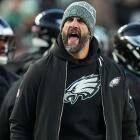History shows high-priced running backs may not be a part of Super Bowl-winning formula
You may want to think twice about sliding a ton of money to a running back

With regards to the skill positions, there's no collection of players that put their bodies on the line more than running backs. On a week in and week out basis, they take a pounding anywhere between 15-25 times per game, especially if they are among the NFL's elite. With that in mind, backs should be pounding their fists for as much dough as humanly possible whenever they hit the negotiating table. You'll get no arguing from me there. That said, if you're a GM of one of these teams looking across the table at a back who is demanding significant dollars, you may want to think twice before shaking hands.
Just a few days ago, the NFL world watched as the Tampa Bay Buccaneers were able to defeat the Kansas City Chiefs in Super Bowl LV. In that championship, Bucs running back Leonard Fournette was a stud. He rushed for 89 yards on 5.6 yards per carry while also notching a key 27-yard touchdown in the third quarter. What makes Fournette's performance even more delightful from Tampa Bay's perspective -- outside of the obvious Super Bowl-winning implications -- is that they were getting it at a bargain. This season, Fournette made a base salary of $2 million after signing on with the Buccaneers after he was released by the Jaguars. That's pennies in the NFL world.
As Marcus Mosher of Raiders Wire points out, Fournette may just be the latest example of why high-priced running backs may not be the formula to winning Super Bowls. Dating back to 2009, the leading rusher on the Super Bowl-winning team has an average base salary of around $1.107 million.
Super Bowl winner leading rusher
| Year | Team | Player | Base salary |
|---|---|---|---|
2020 | Buccaneers | Leonard Fournette | $2,000,000 |
2019 | Chiefs | $1,050,000 | |
2018 | $480,000 | ||
2017 | $900,000 | ||
2016 | Patriots | LeGarrette Blount | $760,000 |
2015 | C.J. Anderson | $585,000 | |
2014 | Patriots | LeGarrette Blount | $730,000 |
2013 | $2,500,000 | ||
2012 | $2,000,000 | ||
2011 | $1,500,000 | ||
2010 | $320,000 | ||
2009 | $460,000 |
Basically, what you can read from this is that you don't need to break the bank for a running back to get yourself a Super Bowl ring. In fact, by not carving out a ton of your cap space to secure your star back, it does open the door to lock in players that have more impact on landing a Lombardi (quarterbacks, offensive tackles, star corners, etc.).
That's only highlighted even further when you look at the top-10 highest-paid running backs in the NFL from this past season. For the most part, their teams didn't do so hot. Eight of those backs were on clubs that failed to make the postseason (Alvin Kamara and Derrick Henry being the exceptions) and owned a 68-91-1 combined record. Not only are teams who are paying top dollar for backs not winning the Super Bowl, but they are barely making the playoffs and can't manage to be over .500.
As we move forward into the offseason and approach free agency, there will be plenty of running backs that ink lucrative contracts. While that makes them a rich man, landing this big fish free agent back may not exactly put their teams on the fast track to a Super Bowl.


















